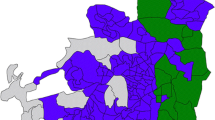Abstract
This paper begins by reviewing the ways in which the innovation of Google Maps has transformed our ability to reference and view geographically referenced data. We describe the ways in which the GMap Creator tool developed under the ESRC National Centre for e Social Science (NCeSS) programme enables users to ‘mashup’ thematic choropleth maps using the Google API. We illustrate the application of GMap Creator using the example of www.londonprofiler.org, which presents a repository of choropleth maps across a range of domains including health, education and other socioeconomic datasets against a backcloth of Google Maps data. Our conclusions address the ways in which Google Map mashups developed using GMap Creator facilitate online exploratory cartographic visualisation in a range of areas of policy concern.





Similar content being viewed by others
Notes
GMap Creator is part of the GeoVUE Project at CASA, a project sponsored by the ESRC as a node in the National Centre for e-Social Science. GMap Creator is developed at CASA by Richard Milton.
Percent volume contours were calculated with a free ArcGIS extension called Hawth’s Analysis Tools developed by Hawthorne Beyer and downloadable from the website http://www.spatialecology.com.
References
Barr, R. (2008). Google and GI science: Revolution, evolution or wild goose?. London: Centre for Advanced Spatial Analysis Seminar, University College London 30th January 2008.
Buckley, A. R., Gahegan, M., & Clarke, K. (2004). Geographic visualization. In R. B. Mcmaster, & E. L. Usery (Eds.) A research agenda for geographic information science. Boca Raton, Fl: CRC.
Corver, M. (2005). Young Participation in Higher Education. HEFCE 2005/03. Bristol: HEFCE.
de Smith, M. J., Goodchild, F. M., & Longley, P. A. (2008). Geospatial analysis: A comprehensive guide to principles, techniques and software tools (2nd ed.). Leicester: The Winchelsea/Troubador.
Dibiase, D. (1990). Visualization in the earth sciences. Bulletin of Earth and Mineral Sciences, Pennsylvania State University, 59(2), 13–18.
Dransch, D. (2000). The use of different media in visualizing spatial data. Computer & Geosciences, 26(1), 5–9.
Erle, S., Gibson, R., & Walsh, J. (2006). Mapping hacks: Tips & tools for electronic cartography. Sebastopol, CA: O’Reilly Media, Inc.
Graham, P. (2007). Web 2.0 (Online). Available from: http://www.paulgraham.com/web20.html. Accessed 24th April 2007.
Longley, P. A., Ashby, D. I., Webber, R., & Li, C. (2006). Geodemographic classifications, the digital divide and understanding customer take-up of new technologies. BT Technology Journal, 24, 67–74.
Longley, P. A., Goodchild, M. F., Maguire, D. J., Rhind, D. W, & , . (2005). Geographic information systems and science. Chichester: Wiley.
Martin, D. (2001). Geographic information systems: Socioeconomic applications. London: Routledge.
Mateos, P., Webber, R., & Longley, P. A. (2007). The Cultural, Ethnic and Linguistic Classification of Populations and Neighbourhoods using Personal Names. CASA Working Paper 116. Available online from: http://www.casa.ucl.ac.uk/working_papers/paper116.pdf
Monmonier, M. (1996). How to lie with maps. Chicago: University of Chicago Press.
Office of the Deputy Prime Minister (2004). Index of Multiple Deprivation (online). Available from: http://www.communities.gov.uk/archived/general-content/communities/indicesofdeprivation/216309/. Accessed 18th December 2007. London: Department of Communities and Local Government.
Purvis, M., Sambells, J., & Turner, C. (2006). Beginning Google maps applications with PHP and Ajax. Berkeley: APRESS.
Silverman, B. W. (1986). Density estimation. London: Chapman and Hall.
Tufte, E. (1990). Envisioning information. Cheshire, CT: Graphic.
Vickers, D., Rees, P. (2007). Creating the National Statistics 2001 Output Area Classification, Journal of the Royal Statistical Society, Series A 170(2).
Author information
Authors and Affiliations
Corresponding author
Rights and permissions
About this article
Cite this article
Gibin, M., Singleton, A., Milton, R. et al. An Exploratory Cartographic Visualisation of London through the Google Maps API. Appl. Spatial Analysis 1, 85–97 (2008). https://doi.org/10.1007/s12061-008-9005-5
Received:
Accepted:
Published:
Issue Date:
DOI: https://doi.org/10.1007/s12061-008-9005-5




